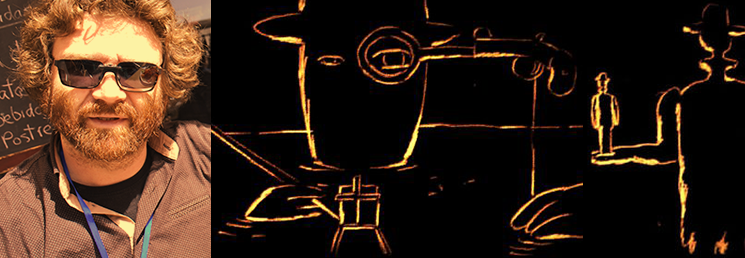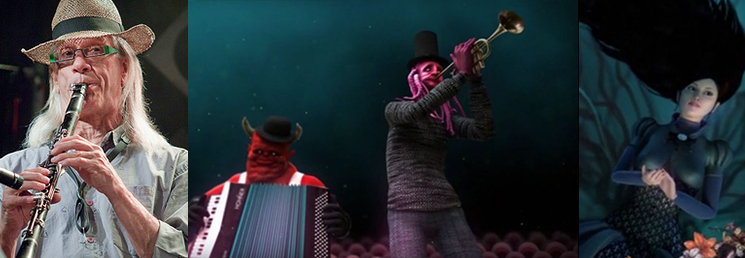- MASTER CLASS WITH RUMEN PETKOV
-

ANIMATION OUT OF THE BOATD TODAY
The Animation world today is very different than just a few years ago.It is different in the way the authors can participate of the distribution of their films and making money from the eventual profit.Today is much easy for a good film to reach the viewers and the independent filmmakers have more choices to communicate with the world.The Distribution Channels are open and the market is huge.
But let's step on the right foundation and leave the technical conversation away because the technical innovation is easy achievable for the young people.
Let us step on the reality and find the way to be part of the animation market.
Today everything is in our hands and depends of the amount of talent we have and our working habits.
The foundation of success and achievements is old like the world.It needs only time updating.
We will talk today about this foundation and the Revelation needed to make out films successful. - MASTER CLASS WITH DIMITAR DIMITROV
-

MAKING MOVIES ON SMARTPHONE OR TABLET
ANIMATION STUDIO THAT FITS IN YOUR POCKET
Why on smartphone and tablet?
The combination of the Wacom and Raugh Animator technologies, combined in a 5.7-inch Samsung Galaxy Note smartphone, gives youfull opportunity for drawing, coloring, playing and exporting animation with the highest quality and process control. The 12-inch Samsung Galaxy Note Pro tablet is suitable for more detailed work, while the Samsung Galaxy Note 3-5 smartphone is ideal for expressive artistic visual solutions due to its smaller display.
After 20 years of work together in animation studios, televisions and the game industry, I started to think more and more that I wanted to make my own movies, completely independent and unaffected by my commercial activities. But this requires time which I cannot allow myself to spend. Then the smartphone found me. It was exactly what I needed, and right on time. Animation studio in my pocket, with which I was able to do animation without preliminary plans, but simply when I had a few free minutes to spare. Take it out and draw. At lunchtime, while the computers are being rendered, in bed at night, at the beach bar. The thin screen, the pressure of the pen, the good brightness of the display, the battery and the weight are a great advantage when drawing outside the studio. The disadvantage for some might be the small screen, but for me this is a plus, because it provides a clearer picture. With my first, entirely drawn on a smartphone movie I participated in over 120 film festivals and received 20 awards. It turns out that smartphone-cinema is becoming more and more popular, as new festivals for this type of movies are being organized constantly and all around the world.
- MASTER CLASS WITH NIK PHELPS
-

IMAGE + SOUND = THE WHOLE PICTURE
Filmmakers work long and hard to get their story pitched perfect, but even after that final edit, the film is only partially complete. Have you ever watched a film with the sound turned down or experienced a film with alternate soundtracks? Even if there is no musical score in the plans, a good foundation of sound design is necessary to bring the audience into the world of the film. Sound sets the landscape and mood, and music can bring emotions and memory into the picture. Rhythm, melody, atmosphere, texture - there are many things we can use to help tell the film's story and even to draw attention from flaws in the film that may exist.
- MASTER CLASS WITH ZBIGNIEW ŻMUDZKI
-

PUPPET ANIMATION
Animation is an art that can be divided into two main sections:
1. Animation taking place under a camera: stop motion animation (puppet animation, object animation, clay animation); classic cut-out; animated material (salt, sand); pixelation
2. Animation created without the film camera: cartoon; 2D animation; 3D animation; non-camera technique.
Puppet animation is a genre which is very important for the Se-ma-for studio.
Puppet animation is an animation technique that physically manipulates a puppet that appears to move on its own. The puppet is moved in small increments between individually photographed frames, creating the illusion of movement when the series of frames is played as a continuous sequence.
Puppet animation (stop motion animation) - animator on the set animates puppets:
Inside the puppets there is a wire or armature that looks like a skeleton - a design that allows precise setting of the next phases of the movement. This metal armature can be covered with different materials. Everything depends on the imagination of the creator, who can use natural (textiles, wood) or synthetic (foam, silicone, latex) materials. The whole film is shot on the set, which is a miniaturized environment.
Experiments with stop motion animation can be used as effects and are often used in live-action films. The very first, unfortunately lost, film involving animal puppets was titled "The Humpty Dumpty Circus". The authors Albert E. Smith and J. Stuart Blackton filmed it in 1898, however the premiere was 10 years later in 1908. Apart from drawing technique, James Stuart Blackton used tricks with objects in many of his films, the most prominent of which is "The Haunted Hotel" from 1907.
In 1899 the Englishman Arthur Melbourne-Cooper shot a short propaganda film, "Matches an Appeal", with characters made out of matchsticks. In 1907 he further developed his technique with "A Dream of Toyland", involving a large sequence of animated toys.
After watching "The Haunted Hotel", the Spanish Segundo Chomón had an inspiration to make a better film using animated objects and additional pixelation - animated people. His "Hotel Electrico" was filmed in 1908.
Russian Alexander Sziriajew experimented with stop motion registration dance performed by puppets in 1906. These films were not discovered until 2008.
However, the most important among the pioneers of this genre is considered to be the Polish Wladyslaw Starewicz. His puppet films go beyond the stage of experimentation and tricks for feature films, and had a wide distribution in cinemas around the world. Wladyslaw Starewicz filmed his movies before the the First World War, first in Kaunas (Lithuania), then in Moscow, and after the Bolshevik Revolution in France. This year marks 114 years since the Moscow premiere of his first puppet film "Beautiful Lukanida."
During my lecture I would like to tell you about puppet animation and puppet show films produced in the studio Se-ma-for.

